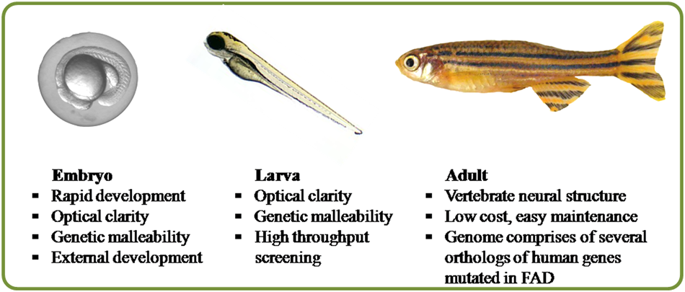当前位置:
X-MOL 学术
›
Cell Death Discov.
›
论文详情
Our official English website, www.x-mol.net, welcomes your
feedback! (Note: you will need to create a separate account there.)
Zebrafish: an emerging real-time model system to study Alzheimer's disease and neurospecific drug discovery.
Cell Death Discovery ( IF 6.1 ) Pub Date : 2018-01-01 , DOI: 10.1038/s41420-018-0109-7 Suraiya Saleem , Rajaretinam Rajesh Kannan
Cell Death Discovery ( IF 6.1 ) Pub Date : 2018-01-01 , DOI: 10.1038/s41420-018-0109-7 Suraiya Saleem , Rajaretinam Rajesh Kannan

|
Zebrafish (Danio rerio) is emerging as an increasingly successful model for translational research on human neurological disorders. In this review, we appraise the high degree of neurological and behavioural resemblance of zebrafish with humans. It is highly validated as a powerful vertebrate model for investigating human neurodegenerative diseases. The neuroanatomic and neurochemical pathways of zebrafish brain exhibit a profound resemblance with the human brain. Physiological, emotional and social behavioural pattern similarities between them have also been well established. Interestingly, zebrafish models have been used successfully to simulate the pathology of Alzheimer's disease (AD) as well as Tauopathy. Their relatively simple nervous system and the optical transparency of the embryos permit real-time neurological imaging. Here, we further elaborate on the use of recent real-time imaging techniques to obtain vital insights into the neurodegeneration that occurs in AD. Zebrafish is adeptly suitable for Ca2+ imaging, which provides a better understanding of neuronal activity and axonal dystrophy in a non-invasive manner. Three-dimensional imaging in zebrafish is a rapidly evolving technique, which allows the visualisation of the whole organism for an elaborate in vivo functional and neurophysiological analysis in disease condition. Suitability to high-throughput screening and similarity with humans makes zebrafish an excellent model for screening neurospecific compounds. Thus, the zebrafish model can be pivotal in bridging the gap from the bench to the bedside. This fish is becoming an increasingly successful model to understand AD with further scope for investigation in neurodevelopment and neurodegeneration, which promises exciting research opportunities in the future.
中文翻译:

斑马鱼:一种新兴的实时模型系统,用于研究阿尔茨海默氏病和神经特异性药物的发现。
斑马鱼(斑马鱼)正逐渐成为人类神经系统疾病转化研究的越来越成功的模型。在这篇综述中,我们评估了斑马鱼与人类的高度神经和行为相似性。它已被高度验证为用于研究人类神经退行性疾病的强大脊椎动物模型。斑马鱼大脑的神经解剖和神经化学途径与人脑极为相似。它们之间的生理,情感和社交行为模式相似性也已得到很好的确立。有趣的是,斑马鱼模型已成功用于模拟阿尔茨海默氏病(AD)和Tauopathy的病理。它们相对简单的神经系统和胚胎的光学透明性允许实时神经影像学检查。这里,我们将进一步详细介绍如何使用最新的实时成像技术来深入了解AD中发生的神经变性。斑马鱼很适合钙2+成像,以无创方式更好地了解神经元活动和轴突营养不良。斑马鱼的三维成像技术是一项快速发展的技术,它可以对整个生物体进行可视化,以便在疾病条件下进行详尽的体内功能和神经生理学分析。高通量筛选的适用性以及与人类的相似性使斑马鱼成为筛选神经特异性化合物的出色模型。因此,斑马鱼模型在弥合从工作台到床边的缝隙方面可以发挥关键作用。这种鱼正成为一种越来越成功的理解AD的模型,并为神经发育和神经变性的研究提供了进一步的空间,这有望在未来带来令人兴奋的研究机会。
更新日期:2019-01-26
中文翻译:

斑马鱼:一种新兴的实时模型系统,用于研究阿尔茨海默氏病和神经特异性药物的发现。
斑马鱼(斑马鱼)正逐渐成为人类神经系统疾病转化研究的越来越成功的模型。在这篇综述中,我们评估了斑马鱼与人类的高度神经和行为相似性。它已被高度验证为用于研究人类神经退行性疾病的强大脊椎动物模型。斑马鱼大脑的神经解剖和神经化学途径与人脑极为相似。它们之间的生理,情感和社交行为模式相似性也已得到很好的确立。有趣的是,斑马鱼模型已成功用于模拟阿尔茨海默氏病(AD)和Tauopathy的病理。它们相对简单的神经系统和胚胎的光学透明性允许实时神经影像学检查。这里,我们将进一步详细介绍如何使用最新的实时成像技术来深入了解AD中发生的神经变性。斑马鱼很适合钙2+成像,以无创方式更好地了解神经元活动和轴突营养不良。斑马鱼的三维成像技术是一项快速发展的技术,它可以对整个生物体进行可视化,以便在疾病条件下进行详尽的体内功能和神经生理学分析。高通量筛选的适用性以及与人类的相似性使斑马鱼成为筛选神经特异性化合物的出色模型。因此,斑马鱼模型在弥合从工作台到床边的缝隙方面可以发挥关键作用。这种鱼正成为一种越来越成功的理解AD的模型,并为神经发育和神经变性的研究提供了进一步的空间,这有望在未来带来令人兴奋的研究机会。






























 京公网安备 11010802027423号
京公网安备 11010802027423号